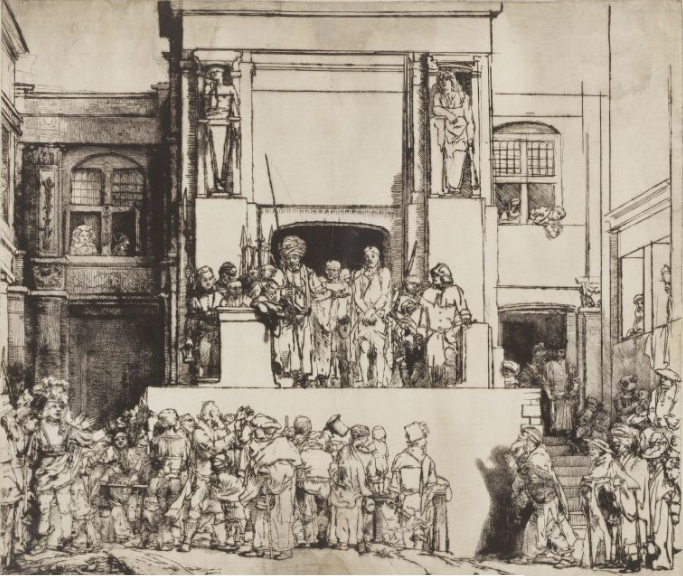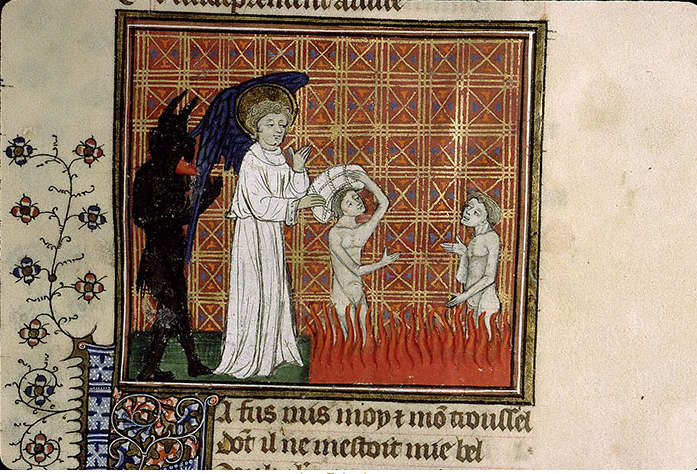Hans Hausser von Ach (1576-1612)
Ecce Homo
c 1603
Pen and ink (brown) on paper (light buff)
26.0 cm x 34.0 cm
The Courtauld Gallery, London
Rembrandt van Rijn (1606 - 1669)
Christ Presented to the People (Ecce Homo)
c 1655
Drypoint, printed in black ink on cream-colored Asiatic wove paper
38.4 x 45.1 cm
The Frick Collection, New York
Christ is presented to the people who clamour for his crucifixion.
It was Pilate and the Romans who ironically referred to Christ as "King"
"Pilate tried to release him; but the Jews cried out, “If you release him, you are not a Friend of Caesar. Everyone who makes himself a king opposes Caesar.”
13 When Pilate heard these words he brought Jesus out and seated him on the judge’s bench in the place called Stone Pavement, in Hebrew, Gabbatha.
14 It was preparation day for Passover, and it was about noon. And he said to the Jews, “Behold, your king!”
15 They cried out, “Take him away, take him away! Crucify him!” Pilate said to them, “Shall I crucify your king?” The chief priests answered, “We have no king but Caesar.”
16 Then he handed him over to them to be crucified"(John 19: 12 - 16)
In the New Testament, Christ is referred to as "King of the Jews" by the Magi, Pilate and the Roman soldiers. He is mocked by the Romans.
On the Cross they affixed the plaque "INRI" - IESVS·NAZARENVS·REX·IVDÆORVM (Iesus Nazarenus, Rex Iudaeorum)
In Quas Primas (1925), in instituting the Feast of Christ the King (now called "the Solemnity of Our Lord Jesus Christ, King of the Universe") Pope Pius XI wrote:
"[T]his power and dignity of Our Lord [as King] is rightly indicated by Cyril of Alexandria. "Christ," he says, "has dominion over all creatures, a dominion not seized by violence nor usurped, but his by essence and by nature."[In huc. x.]
His kingship is founded upon the ineffable hypostatic union. From this it follows not only that Christ is to be adored by angels and men, but that to him as man angels and men are subject, and must recognize his empire; by reason of the hypostatic union Christ has power over all creatures.
But a thought that must give us even greater joy and consolation is this that Christ is our King by acquired, as well as by natural right, for he is our Redeemer.
Would that they who forget what they have cost their Savior might recall the words:
"You were not redeemed with corruptible things, but with the precious blood of Christ, as of a lamb unspotted and undefiled."[I Pet. i, 18-19]
We are no longer our own property, for Christ has purchased us "with a great price"[1 Cor. vi, 20]; our very bodies are the "members of Christ."[I Cor. vi, 15] ...
This kingdom is spiritual and is concerned with spiritual things. ...
On many occasions, when the Jews and even the Apostles wrongly supposed that the Messiah would restore the liberties and the kingdom of Israel, he repelled and denied such a suggestion. When the populace thronged around him in admiration and would have acclaimed him King, he shrank from the honour and sought safety in flight. Before the Roman magistrate he declared that his kingdom was not of this world.
The gospels present this kingdom as one which men prepare to enter by penance, and cannot actually enter except by faith and by baptism, which, though an external rite, signifies and produces an interior regeneration. This kingdom is opposed to none other than to that of Satan and to the power of darkness.
It demands of its subjects a spirit of detachment from riches and earthly things, and a spirit of gentleness. They must hunger and thirst after justice, and more than this, they must deny themselves and carry the cross."








